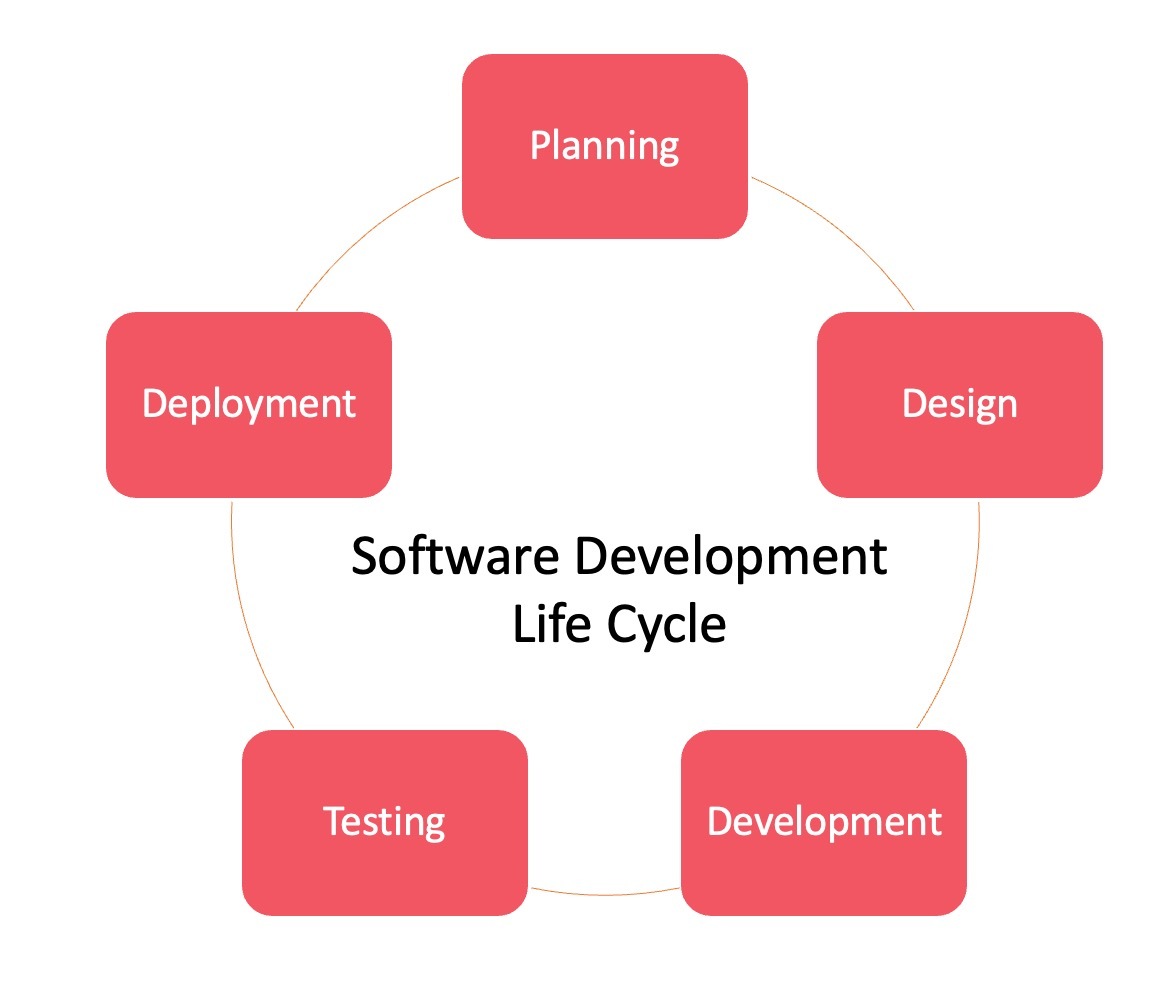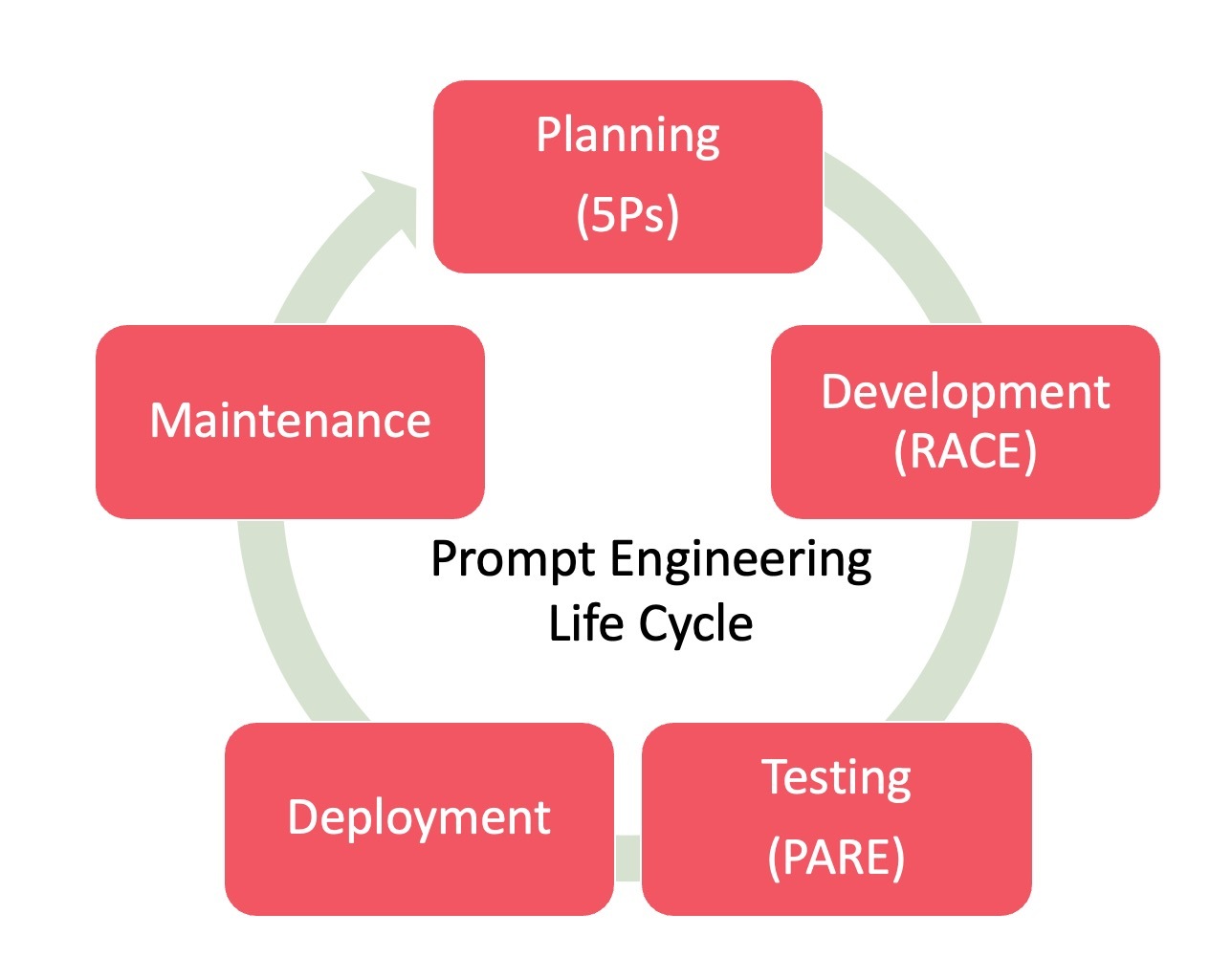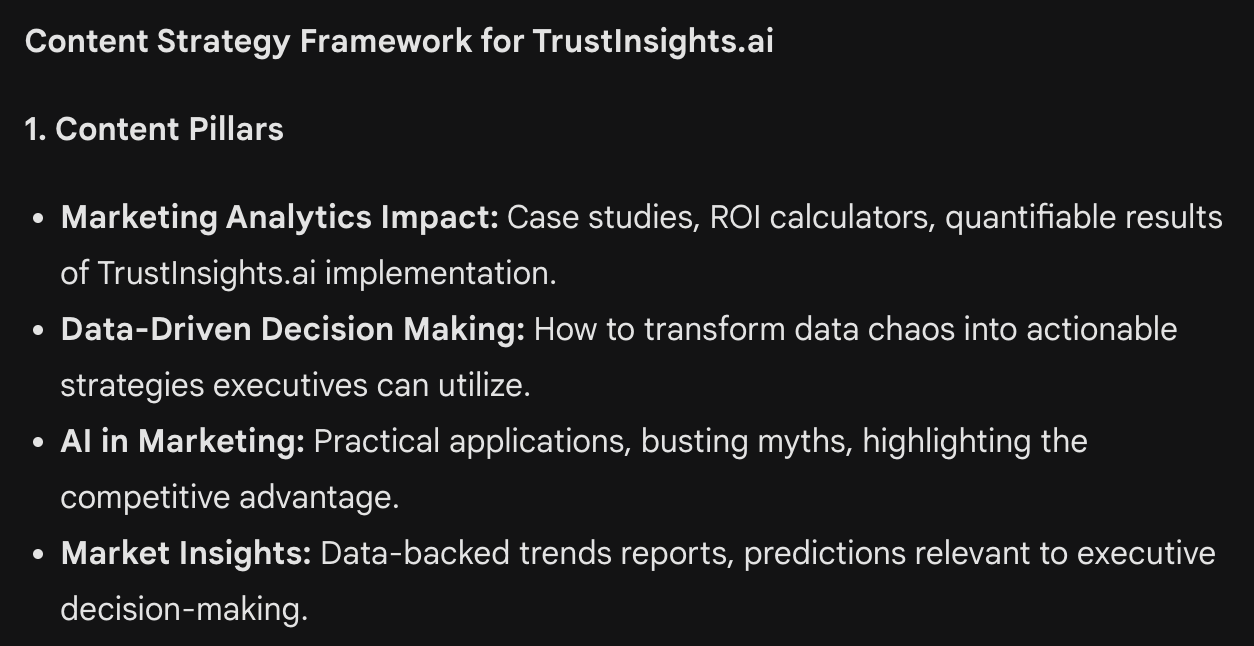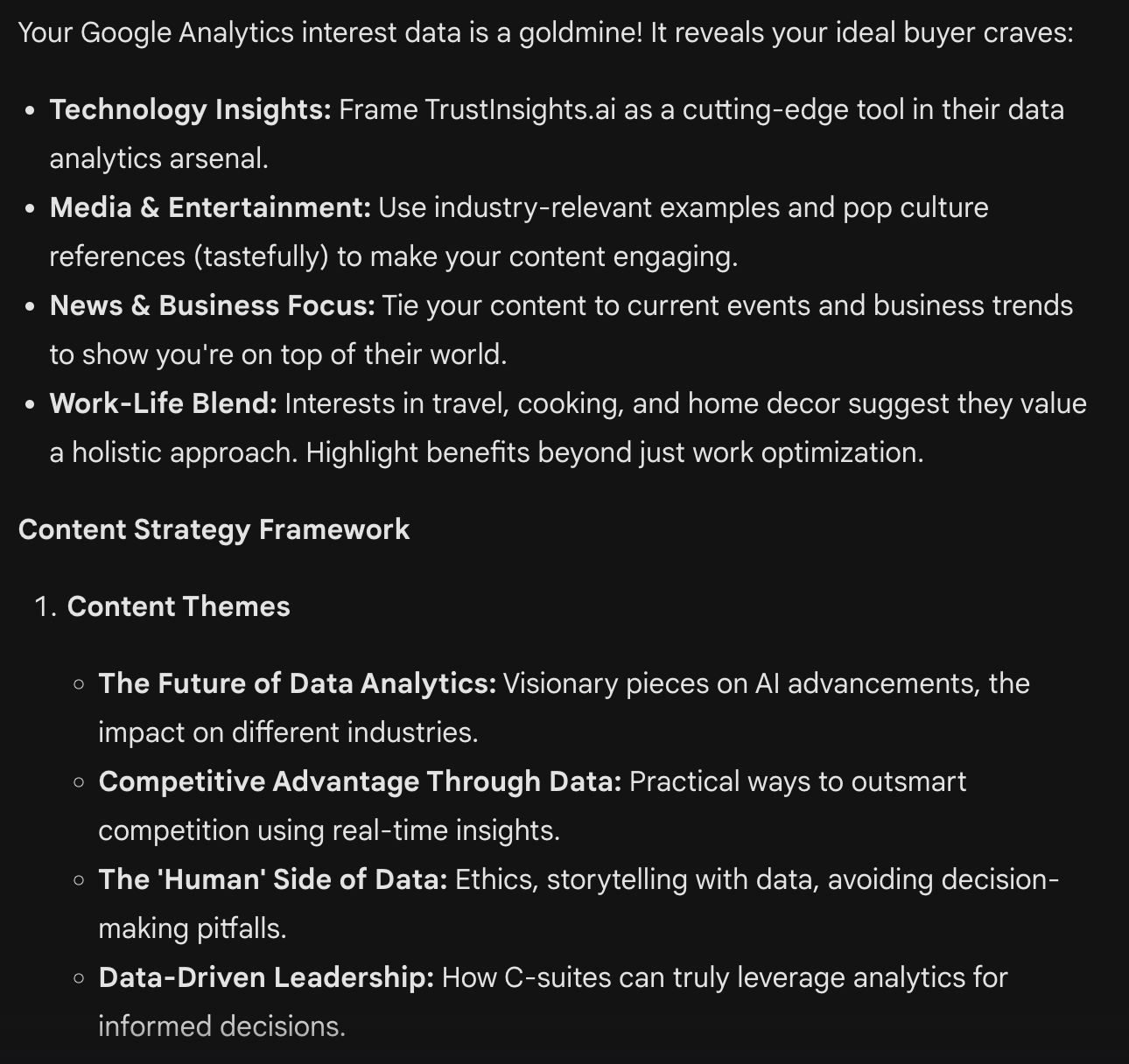INBOX INSIGHTS: The Prompt Engineering Life Cycle, Using Analytics with AI (4/17) :: View in browser

Prompt Engineering Life Cycle
This week, Chris asked if I could speak about how prompt engineering fits into the software development life cycle (SDLC). It’s an interesting question to tackle. This either assumes that prompt engineering is a type of development, or you can use the SDLC for non-technical tasks.
Either way, let’s see what happens.
For context, the software development life cycle (SDLC) was created in the 1960’s to help break down complex business systems. The purpose, at the time, was for systems development that required data and analysis. As programming evolved, the life cycle also evolved and became the framework we know today.
Every company has their own version of the SDLC, but at the core, the phases are roughly the same. Every basic SDLC has Planning, Design, Development, Testing, and Deployment.
At a high level, it should look something like this:

The tasks that go into prompt engineering are very similar to the SDLC. Let’s map the steps.
First, you need a plan. What are you going to do? What is your purpose? For this step I would recommend using the 5P Framework. The 5Ps are Purpose, People, Process, Platform, and Performance. This framework will allow you to efficiently gather your requirements. You’ll know if you need supplemental data or buy-in from other stakeholders. You’ll choose your technology and have a measurable outcome. It will make the development of your prompt go more quickly.
Next, you need to design and develop your prompt. You’ll outline your instructions for a generative AI system. This is where a framework like RACE is useful. RACE is Role, Action, Context, and Execution. This framework will walk you through the steps to construct your prompt, making sure you have the necessary information.
You can grab a copy of the RACE Framework here
Once you’ve developed your prompt you need to test the results. This is where you would use the next framework, PARE. PARE is Prime, Augment, Refresh, and Evaluate. You would use this framework to refine your outcome. You do this by asking questions and poking holes in your initial prompt. When you’re engineering a prompt, you want to spend most of your time in this phase. The RACE Framework is a good start, but it’s the questions that you ask the system that will get you the best results. Remember, these generative AI systems will only do what you ask and nothing more.
You can grab a copy of the PARE Framework here
If you’re satisfied with your results, you can deploy it. Here, you’d save your work into your prompt library for future use. As you have new information or your goals change, you’ll want to update, or maintain your prompts. At a minimum, review your prompts quarterly, or more frequently if they are heavily used.
When you put it all together, it looks something like this:

Not too different visually. The steps are the same. The take away here is that you can rely on existing frameworks that you’re comfortable using to get good results. Prompt Engineering is similar to development in that you need a plan that you can test and refine. Thankfully, there are many frameworks that can help you get the best outcome.
How are you developing your generative AI prompts? Reply to this email to tell me or come join the conversation in our Free Slack Group, Analytics for Marketers.
– Katie Robbert, CEO

Do you have a colleague or friend who needs this newsletter? Send them this link to help them get their own copy:
https://www.trustinsights.ai/newsletter

In this week’s In-Ear Insights, Katie and Chris discuss how the software development life cycle (SDLC) applies to prompt engineering in generative AI, why the prompt development life cycle (or prompt engineering life cycle) is a good idea, and a real-life application of it.
Watch/listen to this episode of In-Ear Insights here »
Last time on So What? The Marketing Analytics and Insights Livestream, we examined data portability and marketing software. Catch the episode replay here!
On this week’s So What? The Marketing Analytics and Insights Live show, we’ll be stepping through the prompt engineering life cycle with live examples. Are you following our YouTube channel? If not, click/tap here to follow us!

Here’s some of our content from recent days that you might have missed. If you read something and enjoy it, please share it with a friend or colleague!
- In-Ear Insights: Prompt Development Life Cycle
- Marketing Hiring Data
- So What? How to get started with Data Portability
- AI Data Governance
- INBOX INSIGHTS, April 10, 2024: 5P Framework Flexibility, Marketing Hiring Data
- In-Ear Insights: 4 Power Questions to Ask Generative AI Language Models
- AI Based Search, Attribution, and Faster Editing!
- Almost Timely News, April 14, 2024:
Generative AI Needs Better Data, Not Bigger Data

Take your skills to the next level with our premium courses.

Get skilled up with an assortment of our free, on-demand classes.
- Powering Up Your LinkedIn Profile (For Job Hunters) 2023 Edition
- The Intelligence Revolution: Large Language Models and the End of Marketing As You Knew It
- Measurement Strategies for Agencies course
- Empower Your Marketing with Private Social Media Communities
- How to Deliver Reports and Prove the ROI of your Agency
- Competitive Social Media Analytics Strategy
- How to Prove Social Media ROI
- What, Why, How: Foundations of B2B Marketing Analytics

In this week’s Data Diaries, let’s talk about analytics and AI. We’ve all collectively spent the last 18 months foaming at the mouth about generative AI – which is a good thing, it’s a transformational technology – but in doing so we’ve forgotten about the vital importance of analytics.
One of the things I talk about in my keynotes on generative AI is that your success or failure with AI will be governed by two factors: the quality and quantity of your ideas, and the quality and quantity of your data. If you have more, better data than a competitor and you have fluency with generative AI, you will deliver better results than someone without that data.
Here’s a simple example. Suppose you’re writing a prompt to help you build a customer profile. Maybe a competitor is doing the same, and you’re both trying to generate a content marketing strategy to earn more audience online.
Let’s say your competitor just uses anecdotal evidence. They say something like “Our ideal buyer is a senior executive at a company with more than $50 million in revenue.” That’s fine, and certainly better than no data at all. However, if you use that fairly generic description as the starting point for your strategic review, you’re probably not going to get a strategy that’s especially well-tuned to your audience.
Here’s an example of what Google’s Gemini returns from this very generic prompt:

Is that terrible? No. it’s not off the mark. But it’s also not going to distinguish our content marketing strategy from anyone else’s.
But suppose you went back to the well of analytics and extracted your audience demographics from Google Analytics 4? Suppose you had the ages, genders, and critically the affinities and interests of your audience, like this, which you can export from either Explore Hub or the API:
| branding_interest | pct_total |
|---|---|
| Technology/Technophiles | 6.214780 |
| Media & Entertainment/Movie Lovers | 4.701336 |
| Lifestyles & Hobbies/Business Professionals | 4.298825 |
| News & Politics/Avid News Readers/Entertainment News Enthusiasts | 4.298825 |
| Media & Entertainment/TV Lovers | 4.161971 |
| Travel/Travel Buffs | 4.137820 |
| Media & Entertainment/Light TV Viewers | 3.944614 |
| Lifestyles & Hobbies/Shutterbugs | 3.872162 |
| Food & Dining/Cooking Enthusiasts/Aspiring Chefs | 3.477701 |
| Banking & Finance/Avid Investors | 3.356947 |
| Shoppers/Shopping Enthusiasts | 2.737079 |
| Technology/Social Media Enthusiasts | 2.712929 |
| Home & Garden/Home Decor Enthusiasts | 2.568024 |
| News & Politics/Avid News Readers/Avid Business News Readers | 2.366769 |
| Media & Entertainment/Music Lovers | 2.141362 |
| News & Politics/Avid News Readers | 2.117211 |
| Media & Entertainment/Book Lovers | 2.020609 |
| Sports & Fitness/Health & Fitness Buffs | 2.020609 |
| Sports & Fitness/Sports Fans | 1.650298 |
| Lifestyles & Hobbies/Family-Focused | 1.561745 |
Would you get a better result, a better customer profile, if you had this information included? Absolutely. And it’s accessible right now, today, in your Google Analytics 4 instance if you’d turned those features on in the past.
What does Gemini return from this?

This is better. It’s still pretty broad, as a content strategy, but it’s significantly more specific than the generic example.
The key takeaway here is to remember the data, analytics, and insights we leveraged in the time before generative AI, and use that WITH our new generative AI tools in every aspect of our marketing. Today, it’s even easier to make use of that data; in the past, we had to interpret what it meant, process it, and integrate it into our planning. Now? We copy and paste the data into our prompts, and let the machines make use of the data, leveraging the value it’s had all along, but we neglected to use as well as we should have.

- New!
Case Study: Predictive Analytics for Revenue Growth
- Case Study: Exploratory Data Analysis and Natural Language Processing
- Case Study: Google Analytics Audit and Attribution
- Case Study: Natural Language Processing
- Case Study: SEO Audit and Competitive Strategy

Here’s a roundup of who’s hiring, based on positions shared in the Analytics for Marketers Slack group and other communities.
- Digital Marketing Manager at NRP Group
- Director Of Content Strategy at Bixal
- Director Of Public Relations, Americas (Investment Management) at Hines
- Director, Internal Communications at Aspen Dental
- Executive Director at Run for Something
- Freelance Data Journalist at hims & hers
- Head Of Sales at Cloverleaf
- Integrated Marketing Manager at Qvest.US
- Marketing Manager – American Girl at Mattel
- Multimedia Content Producer – Editor at Salesforce
- Philanthropic Advisor at Harvard University
- Senior Manager, Sales & Marketing Product Management at GitHub, Inc.
- Sr. Data Platform Security Engineer at Gates Foundation
- Vp – Sustainability at J.Crew
- Vp Social Media at Gregory FCA
- Vp, Community Experience at Chief
- Vp, Corporate Technology at Daniel J Edelman Holdings

Are you a member of our free Slack group, Analytics for Marketers? Join 3000+ like-minded marketers who care about data and measuring their success. Membership is free – join today. Members also receive sneak peeks of upcoming data, credible third-party studies we find and like, and much more. Join today!

Imagine a world where your marketing strategies are supercharged by the most cutting-edge technology available – Generative AI. Generative AI has the potential to save you incredible amounts of time and money, and you have the opportunity to be at the forefront. Get up to speed on using generative AI in your business in a thoughtful way with our new offering, Generative AI for Marketers, which comes in two flavors, workshops and a course.
Workshops: Offer the Generative AI for Marketers half and full day workshops at your company. These hands-on sessions are packed with exercises, resources and practical tips that you can implement immediately.

Course: We’ve turned our most popular full-day workshop into a self-paced course, available now and updated as of April 2024!

Interested in sponsoring INBOX INSIGHTS? Contact us for sponsorship options to reach over 26,000 analytically-minded marketers and business professionals every week.

Where can you find Trust Insights face-to-face?
- Society for Marketing Professional Services, Boston, April 2024
- Society for Marketing Professional Services, Los Angeles, May 2024
- Australian Food and Grocery Council, Melbourne, May 2024
- MAICON, Cleveland, September 2024
Going to a conference we should know about? Reach out!
Want some private training at your company? Ask us!

First and most obvious – if you want to talk to us about something specific, especially something we can help with, hit up our contact form.
Where do you spend your time online? Chances are, we’re there too, and would enjoy sharing with you. Here’s where we are – see you there?
- Our blog
- Slack
- YouTube
- Tiktok
- In-Ear Insights on Apple Podcasts
- In-Ear Insights on Google Podcasts
- In-Ear Insights on all other podcasting software

Our Featured Partners are companies we work with and promote because we love their stuff. If you’ve ever wondered how we do what we do behind the scenes, chances are we use the tools and skills of one of our partners to do it.
- StackAdapt Display Advertising
- Agorapulse Social Media Publishing
- WP Engine WordPress Hosting
- Talkwalker Media Monitoring
- Marketmuse Professional SEO software
- Gravity Forms WordPress Website Forms
- Otter AI transcription
- Semrush Search Engine Marketing
- Our recommended media production gear on Amazon
Read our disclosures statement for more details, but we’re also compensated by our partners if you buy something through us.

Some events and partners have purchased sponsorships in this newsletter and as a result, Trust Insights receives financial compensation for promoting them. Read our full disclosures statement on our website.

Thanks for subscribing and supporting us. Let us know if you want to see something different or have any feedback for us!











2 thoughts on “INBOX INSIGHTS, April 17, 2024: The Prompt Engineering Life Cycle, Using Analytics with AI”